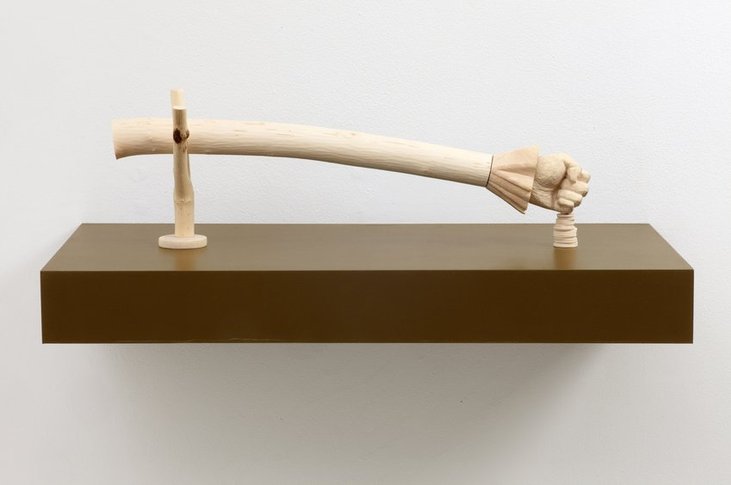
Jane Wilbraham
British, 1967-
(The long arm of) Captain Swing, 2010
Sycamore
20 1/2 x 6 1/4 x 4"
Courtesy of a Private Collection, London
COMMENTS
Wilbraham's sculptural practice is deliberately hermetic, extensive, repetitive and perversely time consuming, so that she can use this making time as a contemplative exercise. Her motifs arise from her relationship with the urban environment, political/economic discourse as well as from a traditional Folk art canon.
The use of carving and whittling is particularly interesting in the current context, says Wilbraham: "The American writers Walter Faurot and E.J Tangerman published their useful and informative guides to whittling and carving during the Great Depression when the practice in the USA arguably reached its height, which suggests that there is a possible psychological link between extreme physical making using obdurate materials, and the experience of those living through economic disruption, trauma, dislocation or uncertainty". Her sculptures are produced alongside watercolours exploring similar subject matter.
For the last five years, Wilbraham has made her sculpture almost exclusively in Sycamore, cut and carved in the green and sourced from the area around her London studio. It is a very hard, tight-grained, creamy white wood that is readily available, self-seeding prolifically on urban waste ground as well as in the field, and it was often traditionally used in vernacular British folk art including Welsh love spoons, clog soles and various utilitarian kitchen implements. For Wilbraham, it carries the dual potential of resourcefulness and poetry.
Jane Wilbraham (b. Shropshire, UK, 1967) studied at The Ruskin School or Drawing and Fine Art (1987-90), The Slade School of Art (1990-92). She spent 1993-1995 on residency at Rijksakademie van Beeldende Kunsten, Amsterdam. Wilbraham lives and works in London.
Selected shows include British Museum (London), The New Art Gallery, (Walsall, UK) and Hales Gallery (London). Wilbraham's work is included in various private and public collections including the International Collage Center (US), British Museum (UK), UBS (UK), Fidelity (UK), C12 (US) and Oxford University (UK).
- "Jane Wilbraham," Hale's Gallery, Web, 2013
SBMA CURATORIAL LABELS
BORN 1967, SHROPSHIRE, ENGLAND
LIVES AND WORKS IN LONDON
Jane Wilbraham questions systems of value and labor through her materials and methods. In 2008, having returned for a time to rural Shropshire in the English Midlands, the artist was drawn to the region’s folk art, and began to research traditional crafts such as whittling.
In (The long arm of) Captain Swing, Wilbraham merges her interest in carving with historical protests, namely the Swing riots of 1830. Rural workers wrote threatening letters to landowners whose threshing machines were replacing human labor, and signed them with the name of their invented leader “Captain Swing.”
Nothing Left to Make combines traditions of chain-making with motifs found in lovespoons — hand-carved tokens of affection used in courting rituals in Wales and parts of Northern and Eastern Europe. The watercolor Crushed makes reference to the economic history associated with oyster shells embedded in the streets of London. While more readily associated with wealth today, oysters were inexpensive in the nineteenth century and their shells were tossed onto the ground by people eating them on the streets.
Labour and Wait, 2013
